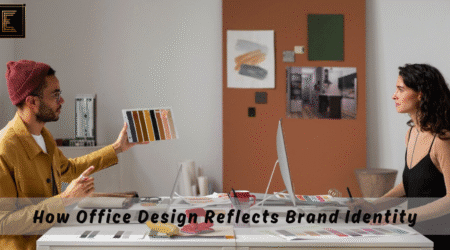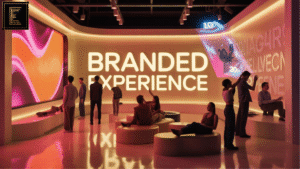Table of Contents
In today’s saturated market, creating great products or services isn’t enough. Brands must also deliver memorable, consistent, and emotionally engaging experiences. Poor customer experiences can diminish brand loyalty, disrupt engagement, and ultimately lead to lost revenue. Understanding the 5 Common Mistakes Brands Make in Experience Management is the first step toward building stronger customer connections.
Whether you’re reimagining a retail store, office space, or hospitality setting, knowing how to improve brand experience with space design can be the game-changer your brand needs. In this post, we’ll explore common pitfalls and demonstrate how smart experiential design plays a crucial role in brand transformation.
Mistake #1: Inconsistent Brand Storytelling Across Spaces

“Your brand is a story unfolding across all customer touch points.” – Jonah Sachs
Inconsistency in storytelling across your physical spaces can be confusing. A brand that feels premium online but looks ordinary in-store creates a disconnect that undermines trust. This is one of the biggest brand experience management mistakes to avoid.
How Smart Design Can Fix It:
Smart, cohesive design ensures that every location reflects your brand identity—from color schemes and furniture to spatial arrangement and lighting. Maintaining this consistency communicates reliability and professionalism.
The role of experiential design in brand experience management is to bring your brand’s story to life in a unified way. It bridges digital and physical touchpoints to ensure seamless experiences.
Mistake #2: Neglecting Emotional Engagement

Many brands focus on operational efficiency and forget the emotional side of the customer journey. Spaces that feel cold or overly functional do little to inspire loyalty or affection.
“People will forget what you said, people will forget what you did, but people will never forget how you made them feel.” – Maya Angelou
How Smart Design Can Fix It:
Designing for emotion means incorporating tactile materials, ambient lighting, aroma, music, and color psychology. Elements like soft ambient lighting or interactive features invite deeper emotional interaction, making the brand more memorable.
Understanding how to improve brand experience with space design starts by acknowledging that emotion drives decision-making. A space that feels welcoming, inspiring, or comforting makes a powerful impact.
Mistake #3: Ignoring the Flow and Functionality

“Design is intelligence made visible.” – Alina Wheeler
Many businesses underestimate the importance of layout and space flow. Poor signage, awkward pathways, or confusing layouts frustrate customers and diminish the experience.
How Smart Design Can Fix It:
Intelligent spatial planning improves traffic flow, enhances accessibility, and directs customer attention naturally to key areas. From zoning to interactive stations, every element should be designed with purpose.
Avoiding this pitfall is one of the best practices for successful brand experience strategy. A well-structured space not only looks good but also performs optimally.
Mistake #4: Lack of Personalization

Today’s customers expect more than a one-size-fits-all experience. Failing to acknowledge different customer personas or preferences is another major brand experience management mistake to avoid.
How Smart Design Can Fix It:
Personalization can be achieved through modular layouts, flexible seating, localized content, or data-driven displays that adjust to the user. These features cater to different audiences without compromising the brand’s core identity.
The role of experiential design in brand experience management also involves harnessing technology to deliver adaptive experiences that make every visitor feel seen and valued.
Mistake #5: Not Measuring the Impact of Experience

Too many brands invest heavily in aesthetics but fail to track the ROI of their experience design. Without analytics, it’s impossible to know what’s working and what isn’t.
How Smart Design Can Fix It:
Smart environments incorporate tech like heat maps, sensors, customer feedback stations, and mobile integrations. These tools provide insights that guide iterative improvements.
Following the best practices for successful brand experience strategy means treating your space as a dynamic entity—one that evolves based on real-time customer behavior.
Conclusion: Design Your Brand Experience to Win Hearts
Smart design is more than decoration—it’s strategy made visible. The 5 Common Mistakes Brands Make in Experience Management can derail even the most well-intentioned brand efforts, but each can be solved through thoughtful experiential design.
At Elegant Designs, we specialize in transforming spaces into emotionally resonant, functional, and brand-aligned environments. Whether you’re looking to refine your retail space, elevate a hospitality brand, or create an immersive office experience, we’re here to help you experience the next level of modern interior lighting and spatial design.
Avoiding brand experience management mistakes to avoid isn’t just about fixing what’s broken—it’s about designing a better journey from the ground up. Let us show you how to improve brand experience with space design that speaks louder than words.
FAQs
1. What are the 5 Common Mistakes Brands Make in Experience Management?
The most common mistakes include inconsistent storytelling, lack of emotional engagement, poor flow and layout, lack of personalization, and failing to measure experiential ROI.
2. Why is design important in brand experience?
Design is crucial because it shapes how customers feel, interact, and remember your brand. It brings your brand values to life through visual and spatial storytelling.
3. How can I improve brand experience with space design?
Focus on cohesive branding, emotional triggers (like lighting and materials), personalized experiences, and functional layouts. Use technology to track and evolve the design.
4. What is the role of experiential design in brand experience management?
Experiential design translates brand strategy into immersive spaces. It creates emotional connections and ensures consistency across physical environments.
5. What are the best practices for successful brand experience strategy?
Start with customer research, design for both function and feeling, test your layouts, use adaptive technologies, and always align the space with your brand identity.







